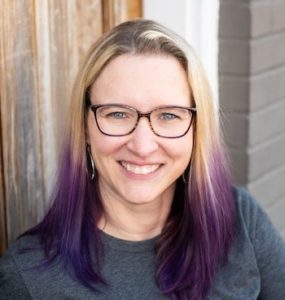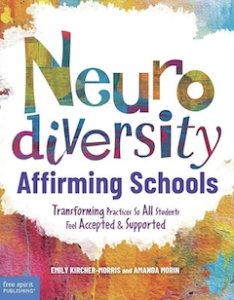By Amanda Morin and Emily Kircher-Morris


Amanda
Educators today face a critical and exciting opportunity: creating schools where every student, regardless of how their brain works, feels accepted, supported, and valued. Embracing neurodiversity-affirming practices in education can profoundly transform learning environments, making schools inclusive spaces that empower neurodivergent students.
The Evolution of the Neurodiversity Movement


Emily
The neurodiversity movement began as a grassroots effort led by the autistic community, advocating for acceptance, understanding, and the dismantling of pathologizing narratives around autism. From its origins in autism advocacy, the movement has expanded to include a broader definition of neurodivergence, including individuals with ADHD, dyslexia, and other neurodevelopmental differences. This expansion is informing inclusive practices across education, the workplace, and broader society.
This evolution has shaped how we view disability and different neurotypes in education. Rather than forcing students to conform to rigid systems, we realize now that we must adapt those systems to support neurological diversity.
The central message is clear: neurodivergent brains are not broken or in need of “fixing” – they are simply different, and those differences are valuable.
Understanding Neurodiversity, Neurodivergence, and Neuro-Normativity

 Neurodiversity recognizes that every person’s brain functions uniquely, contributing a wide array of perspectives, skills, and ideas to society. When we use the word neurodiverse, we speak about the entire human population, recognizing the inherent variation in how brains process information and respond to the world.
Neurodiversity recognizes that every person’s brain functions uniquely, contributing a wide array of perspectives, skills, and ideas to society. When we use the word neurodiverse, we speak about the entire human population, recognizing the inherent variation in how brains process information and respond to the world.
Neurodivergent, however, specifically describes individuals whose neurological characteristics diverge significantly from what society has established as norms. Conditions typically classified under neurodivergence include autism, ADHD, dyslexia, dysgraphia, dyscalculia, epilepsy, and Tourette’s syndrome. Neurodivergent individuals often experience distinct challenges when environments are structured without consideration of their neurological needs.
In contrast, the term neuro-normative describes individuals whose neurological traits closely align with societal norms and expectations. The neuro-normative experience forms the basis of most educational systems and curricula, inadvertently making it difficult for neurodivergent students to navigate. We use the term neuro-normative instead of neurotypical to emphasize that what is considered ‘typical’ is not inherently natural or universal, but rather shaped by dominant cultural and systemic expectations. This language highlights the constructed nature of the norms themselves.
Why are these semantic distinctions crucial for educators? Understanding the difference between neurodiverse (everyone), neurodivergent (those who significantly diverge from norms), and neuro-normative (those who align closely with norms) helps educators develop specific strategies that genuinely meet the needs of all students, especially those who have traditionally been underserved or misunderstood.
Neurodiversity-Affirming: An Approach, Not a Checklist
Being neurodiversity-affirming is not about applying a one-size-fits-all checklist or implementing isolated accommodations. Rather, it involves deeply reshaping educational practices, curricula, and school culture to consistently acknowledge and respect neurological differences. This holistic approach helps students embrace their neurotype, recognize and cultivate their unique strengths, and learn to manage challenges effectively.
A neurodiversity-affirming mindset requires educators to shift from compliance-based support models to strength-based, student-centered practices. For example, instead of attempting to reduce autistic traits, educators might create sensory-friendly spaces, provide clearer instructions, and structure routines that support an autistic student’s comfort and participation.
Similarly, a student experiencing anxiety – distinct from neurodivergence – benefits from targeted interventions aimed at reducing and managing that anxiety, creating an environment that feels emotionally safe and predictable.
Language Matters: Moving Beyond Labels
Language significantly influences not only how students perceive themselves, but also how educators and their peers perceive them. Many educators were initially taught to use person-first language (e.g., “a student with autism”), reflecting the intention of not defining a student by their diagnosis. However, many neurodivergent individuals prefer identity-first language (e.g., “an autistic student”) because it acknowledges their identity as inseparable from their neurotype.
This distinction matters because the language we choose conveys values. While person-first language emphasizes individuality, identity-first language affirms neurodivergence as an essential part of who someone is. Importantly, there is no one “right” choice – what matters most is honoring how a person wants to be identified.
Educators can navigate this thoughtfully by engaging directly with students, families, and communities about their language preferences. By doing so, educators model respect, empower individual autonomy, and affirm each student’s identity, reinforcing a culture of inclusivity.
Implementing Small, Seismic Shifts
Creating neurodiversity-affirming schools doesn’t require sweeping transformations. Educators can initiate meaningful changes with small, incremental adjustments:
► Adjust classroom environments. Consider the sensory needs of all of your learners. Some of them may benefit significantly if you dim the fluorescent lights, provide noise-canceling headphones, or designate a quiet corner. These sensory-friendly changes can have a profound impact on neurodivergent students’ ability to engage.
► Offer flexible modes of learning and expression. Allow students to choose how they demonstrate their understanding through multiple modalities, like writing, drawing, speaking, or more hands-on techniques like building or even baking. This flexibility supports diverse processing styles and taps into student strengths.
► Teach executive functioning skills explicitly. Rather than assuming all students intuitively manage time or organize materials, integrate these skills into daily instruction. Use visual schedules, checklists, and modeling to support independence.
► Deconstruct behavioral expectations. Rethink what constitutes “appropriate” behavior. Consider whether classroom expectations solely reflect neuro-normative standards and, if so, adjust them to include multiple ways of communicating, engaging, and self-regulating.
► Use inclusive language and framing. Replace deficit-based descriptions (e.g., “disruptive,” “lazy”) with language that seeks to understand underlying needs (e.g., “has difficulty with transitions,” “may benefit from movement breaks”).
► Create predictable, student-centered routines. Provide consistency and clarity in routines to help reduce anxiety and support all learners. Co-constructing classroom norms and schedules with students can foster ownership and trust.
These small steps can have seismic impacts on what students learn and how they engage in their education. Whether it’s shifting how we respond to behavior, designing alternative ways to demonstrate learning, or simply changing our language, each small change builds toward a more inclusive and supportive environment.
Finding Your Community
One key aspect of driving these shifts is finding and building community with like-minded colleagues. Sharing experiences, resources, and support can sustain educators’ commitment and creativity.
The value of a supportive community dedicated to implementing neurodiversity-affirming practices cannot be overstated. When educators find their “people” – those who share their goals and mindset – they feel more supported, encouraged, and equipped to push through the slow pace of systemic change.
For instance, Neurodiversity University’s Educator Hub, a community co-facilitated by the authors of this article, is dedicated to implementing neurodiversity-affirming practices. Participating in roundtables, office hours, and webinars provides educators with invaluable collaborative learning experiences, fostering professional growth and personal empowerment.

The Time for Change Is Now
Neurodiversity-affirming practices are gaining momentum because educators, families, and communities are realizing that traditional educational systems have not fully supported neurodivergent learners. With growing awareness, educators today have a unique opportunity – and responsibility – to drive meaningful change.
Creating neurodiversity-affirming schools is not merely an educational shift; it’s an act of advocacy, equity, and justice. It ensures that every student can learn authentically, express themselves openly, and thrive academically and socially.
Educators, the journey starts with us. By committing to understanding, inclusion, and continuous growth, we can build schools where every brain truly belongs.
Image credit: Shutterstock

 Emily Kircher-Morris, LPC, is the host of The Neurodiversity Podcast, which explores the psychological, educational, and social needs for enriching the lives of neurodivergent people. She is the author of several books including the co-author of the book, Neurodiversity-Affirming Schools: Transforming Practices So All Students Feel Accepted & Supported (Free Spirit Publishing, 2025) and author of Teaching Twice-Exceptional Learners in Today’s Classroom (Free Spirit Publishing, 2021), which focuses on supporting 2e learners in the educational setting. (See her MiddleWeb article here.) She practices as a mental health counselor outside of St. Louis, Missouri.
Emily Kircher-Morris, LPC, is the host of The Neurodiversity Podcast, which explores the psychological, educational, and social needs for enriching the lives of neurodivergent people. She is the author of several books including the co-author of the book, Neurodiversity-Affirming Schools: Transforming Practices So All Students Feel Accepted & Supported (Free Spirit Publishing, 2025) and author of Teaching Twice-Exceptional Learners in Today’s Classroom (Free Spirit Publishing, 2021), which focuses on supporting 2e learners in the educational setting. (See her MiddleWeb article here.) She practices as a mental health counselor outside of St. Louis, Missouri.
Amanda Morin, CBHS, is a neurodivergent neurodiversity activist, an early childhood and behavioral specialist, certified teacher, and nationally known speaker, who is deeply committed to fostering accessible and inclusive environments. She is the co-author of the book, Neurodiversity-Affirming Schools: Transforming Practices So All Students Feel Accepted & Supported (Free Spirit Publishing, 2025), and has written five other books, including Adulting Made Easy: Things Someone Should Have Told You About Getting Your Grown-Up Act Together, (Sixth & Spring, 2021), What is Empathy? (Rockridge Press, 2020) and The Everything Parent’s Guide to Special Education (Adams Media, 2014). She lives in coastal Maine.








